At Wild Rescue Wildlife Sanctuary and Nature Reserve, we had the pleasure of staying in a beautiful stone-walled thatched cottage built in the Cape style. We had the opportunity to walk along narrow trails through intriguing vegetation in the reserve, which is classified as a Critical Biodiversity Area. Because of its variety of contrasting soil types, all the major plant communities of the Agulhas coastal plain can be found in close proximity in the 165-hectare nature reserve.

Four self-guided walking trails are marked out at Wild Rescue Wildlife Sanctuary and Nature Reserve, which is situated almost midway between Riversdale and Still Bay in the Western Cape
We visited Wild Rescue to pick up our friend (who had travelled with us from Pietermaritzburg and had stayed there while we were at Onrus). We took up the offer of Wild Rescue’s founder, Gill Simpson, to stay in one of the two fully equipped off-grid self-catering cottages that accommodate visitors for minimum stays of 2 nights. (Currently, rates are R550 per night per one-bedroomed cottage, which can sleep up to 4 people.)

The gracious main house at Wild Rescue, which includes accommodation for long-term and short-term volunteers. For information on volunteering see https://wildrescue.co.za/volunteer/#top
Gill and our friend had met some years ago because they were both working in wildlife rescue and rehabilitation, particularly caring for primates. Gill founded Wild Rescue, a registered non-profit organisation (NPO), in response to the need in the Western Cape for a sanctuary for wildlife, including primates.
At the end of 2017 Wild Rescue obtained approval from the provincial conservation authority, Cape Nature, to establish a wildlife rehabilitation sanctuary. A building formerly used as farmworker accommodation has been substantially altered to be used as a rehab clinic, and a solar-powered water system fed by local spring water has been completed. Wild Rescue is in the process of raising funds to complete building enclosures and other facilities for rescued animals.
Once these facilities are in place, in terms of its permit, Wild Rescue will be able to provide long-term care and rehabilitation for several species of antelope, banded and Cape grey mongoose, porcupine, bat-eared fox, scrub and Cape hare, caracal, black-backed jackal, and tortoises that are indigenous to the Western.
Regarding baboons and monkeys, Wild Rescue has permission to take in such primates only from approved captive institutions for long-term care. Rehabilitation for primates is restricted to their immediate care and immediate return to the group they came from in the wild.

The view from the walking trail near the cottages to the Goukou River on the eastern boundary of the nature reserve
Gill bought the Wild Rescue property in 2015 using her life savings. It had already been proclaimed as a Nature Reserve back in 1994, due to the diversity of plants found here. In 2017, Wild Rescue rezoned more than 50% of the property as “Open Space 3”, ensuring that large sections of the reserve will be protected as a corridor for wildlife.
In addition to the wildlife rescue and rehabilitation project, the conservation purpose of the nature reserve is not only to conserve its diverse plant communities and associated wildlife, but also to play an educative role using its well-equipped and welcoming education centre. The educational aspect will be expanded to include environmental camps for school children. It is also hoped that Wild Rescue can open discussion and debate with neighbours regarding habitat and biodiversity protection. For more on Wild Rescue’s education objectives see https://wildrescue.co.za/educate/
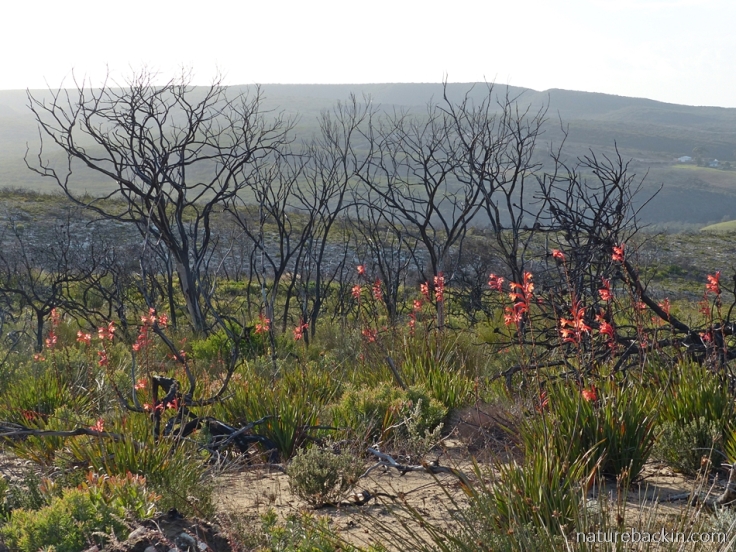
An early morning view on one of Wild Rescue’s walking trails showing red watsonia (Watsonia angusta) in flower between the burnt remains of plants that were killed in a major fire, which lasted four days in January 2017
Wild Rescue Nature Reserve is situated in an eco-region that is part of the exceptionally diverse Cape Floral Kingdom in the southern part of the Western Cape in South Africa. Although the Cape Floral Kingdom occupies only 6% of South Africa, it contains one third of all plant species in the country. The total number of plants species in the Cape Floral Kingdom is 8700 and most of these species (68%) occur only in the region and nowhere else, that is they are endemic, and many have extremely localized distribution. Partly because many plant species occur only in very specific areas a high number of species – about 1700 species – are under threat of extinction.
The Fynbos Biome, with a high percentage of endemic plants, is the biome with which the Cape Floral Kingdom is most usually associated, although there are other vegetation biomes in the Cape Floral Kingdom, such as the Succulent Karoo Biome. Fynbos (literally fine-leaved) has two major groupings, one being the shrubby grassland known as the Renosterveld vegetation group (comprising 1000 species), and the other being the Fynbos vegetation group (7000 species), which characteristically includes restiod (Cape reed), ericoid (heath) and proteoid (including proteas) components as well as other plant families. (For further information about the complexities of the Fynbos Biome see http://pza.sanbi.org/vegetation/fynbos-biome.)

The Still Bay (or Mossel Bay) pincushion (Leucospernum praecox), photographed on a morning walk at Wild Rescue, is locally endemic. It occurs only on the Riversdale Flats between Albertinia and Mossel Bay, growing in white sandy soil at an altitude of 0-250m
I found the Still Bay pincushion very interesting, in part because the flowers become darker with age and after being pollinated, and so there are different-coloured flowers on one plant. It takes two months for seeds to ripen in the flowerheads. After falling to the ground, seeds are taken underground by ants. The ants eat only the fleshy outer-covering of the seeds, and the seeds themselves remain buried in the ground. Although mature Still Bay pincushion plants are killed by fire, the buried seeds survive and can germinate after a fire. For this reason these plants are dependent on ants for their survival. (For more on this plant see http://pza.sanbi.org/leucospermum-praecox).
Gill told us that fynbos should only be burnt every 11 to 15 years depending on the type of plants and soils in the region. If fynbos is burnt too often and before plants have had a chance to mature enough to set seed, species of plant can be eradicated by fires.
Because of diminishing habitat, the Still Bay pincushion is listed as Vulnerable on the Red Data List. It is one of several vulnerable or threatened species that occurs in the Wild Rescue Nature Reserve.

While we were walking, this fantastic plant caught my eye. It turned out to be a Molbossie (Aspalathus dasyantha), an endangered species endemic to predominantly limestone soils on the coastal plains south of Riversdale and Albertinia. Aspalathus means ‘scented shrub’ but alas, I did not verify this – I resolve that from now on I will be sniffing more of the wild flowers I come across!
Reasons for the decline in the population of this lovely plant are invasive alien acacia plants, habitat degradation through thatch harvesting and too frequent fires. Fire management is complex, especially in dry times when frequent unplanned or runaway fires can have a devastating effect.
At Wild Rescue, the most prolifically invasive alien plant is the rooikrans (Acacia cyclops) and it is methodically cleared in an ongoing programme. In 2017 special funding enabled the clearance of a significant area of mature rooikrans trees. The continuing clearance generates some local employment opportunities. The cleared alien trees provide Wild Rescue with wood to be used as firewood, for building, and to sell locally as firewood to generate funds. Volunteers spend time removing newly generated rooikrans seedlings.

Making the Molbossie particularly eye-catching are the different coloured flowers on the same plant – the flowers change colour with age, starting off yellow, moving through a reddish colour through to a purple-mauve
In my post on our walk in the Gamkaberg I featured a photo of a yellow-flowered Hermannia species – the first time I had become aware of this genus. I have since read that there are 141 South African Hermannia species, of which 81 are endemic to South Africa (http://pza.sanbi.org/hermannia). The Afrikaans name for Hermannia species in general is poproos or poprosie, which descriptively means doll’s rose. I was charmed by several species of Hermannia that I saw while walking at Wild Rescue.

I think this vibrantly coloured flower may well be Hermannia flammea

Another lovely species of Hermannia, which I photographed in bright morning light, nodding vigorously in the gusting wind. Possibly it is H. concinnifolia, endemic to the Bredasdorp-Riversdale region

I am not sure, but this lovely white-flowered plant with silver hairs gleaming in the sunshine, looks to me that it may well be another species of Hermannia
Many fynbos plants appear to be an intriguing mixture of toughness and delicacy – I share with you below some of my favourites, or at least those that I was able to photograph in bright and windy conditions while trying to keep up with my walking companions.

A species of lobelia, perhaps the Lobelia coronopifolia, its vibrant blue almost unbelievable against the sand and stone

The Butterfly Lily (Wachendorfia paniculata), endemic to the Western, Eastern and Northern Cape

Photographed on a walk in the late afternoon, we saw the low-growing flower of the Soetuintjie (Moraea fugax), which only flowers in the afternoon. Although each flower only lasts a few hours (fugax means fleeting or ephemeral), each plant produces a succession of flowers in the flowering season. I gather that there are also blue-mauve and yellow versions of this flower. The bulb is edible

I think that this white-flowered everlasting is Syncarpha argyropsis, which is distributed along the southern coast from Betty’s Bay to Riversdale

The reason for the common name, Drumstick, for the Zaluzianskya capensis is that the unfurled buds resemble little drumsticks. The flowers open in the late afternoon and stay open through the night, releasing a strong scent, and they close again as the morning light intensifies. They are pollinated by night-flying moths

Gill Simpson leading a walk along one of the trails with a view down to the Goukou River that forms the eastern boundary of the reserve. Unfortunately invasive alien black wattle (Acacia mearnsii) trees line the far bank and encroach into the reserve

In this part of the reserve more robust succulents such as this Euphorbia heptagona were more evident than in the rocky limestone section
Adding to the diversity at the nature reserve is a wetland with extensive reedbeds providing roosting sites for many birds including Barn Swallows (also known as European swallows). The reserve is endowed with several fresh water springs, and a dam near the main house provides a natural swimming pool.

The small dam provides an enticing swimming spot for visitors during the warmer months
The two self-catering cottages are about 500 metres from the main house and provide secluded accommodation for visitors. There is no electricity, but there are oil lamps and candles for lighting, and a gas hob, a gas fridge and hot water from a gas geyser.
The cottages each have a fully equipped kitchenette that is open-plan with the seating and dining area with an indoor fireplace. Firewood is provided. The outside patio overlooking the river valley has a built-in brick braai/barbecue. Although the cottages are near to each other, they are far enough away for privacy and a wooden screen means that the two patios do not overlook each other. For more details on the cottage accommodation see https://wildrescue.co.za/accommodation/

The comfortable sitting room and dining area that is open-plan with the kitchen

The open-plan kitchen area that is equipped with everything needed for a self-catering stay

The bedroom with comfortable beds (one double and one single), bed linen and towels (with thoughtfully provided chocolates) and an en-suite bathroom with a hot water shower
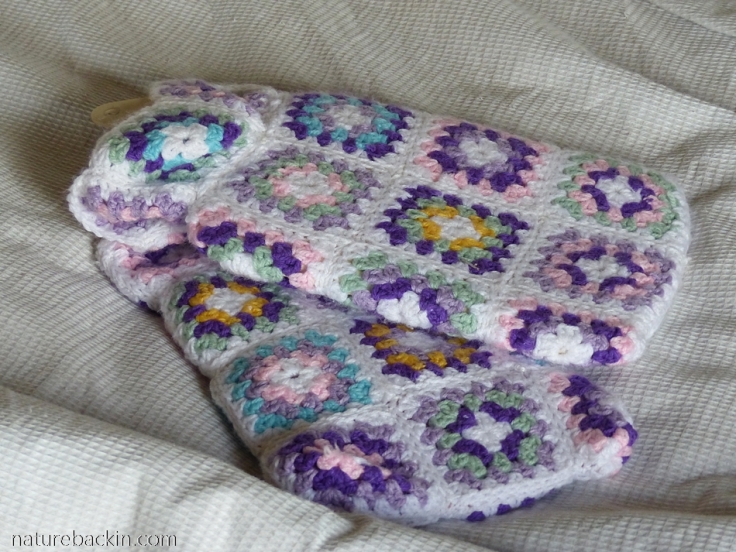
A welcome find on a chilly night were hot water bottles in their hand-crocheted covers

The serene view from the cottage in the morning light

This Greater Striped Swallow perched nearby keeping an eye on us drinking our morning coffee on the patio, while hoping to hawk insects on the wing

The well-designed cottages were built using stones from old ruins on the property
Wild Rescue Wildlife Sanctuary and Nature Reserve provides the visitor with a superb getaway experience for those looking for off-grid seclusion and the chance to walk in nature in such a richly endowed critical biodiversity area. It is also a bonus to support such a worthwhile project. To find how to support the work of Wild Rescue or enquire about accommodation, visit the website https://wildrescue.co.za/ or email wildrescue@mweb.co.za. More information about Wild Rescue is available at https://www.facebook.com/WildRescueWC/


Posted by Carol



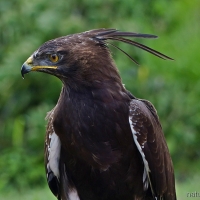

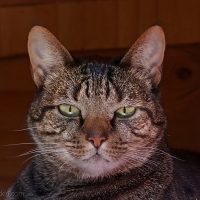
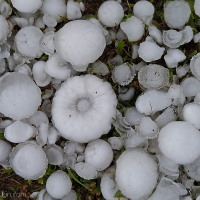

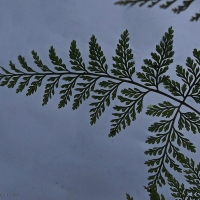
December 14, 2019 at 6:45 am
Your blog is amazing..and felt that I never miss any posts from your site so started to follow you… 🙂
Thank you for sharing all those wonderful nature experiences..
LikeLiked by 1 person
December 14, 2019 at 2:01 pm
Thanks very much for the follow, and glad that you also enjoy nature 🙂
LikeLiked by 1 person
December 14, 2019 at 2:19 pm
👍👍👍
LikeLiked by 1 person
December 9, 2019 at 3:05 am
What a magical, marvelous spot to visit. The Soetuintjie (Moraea fugax) looks quite a bit like our wild irises that come in bright yellow to a deep purple/blue and pale white. The area behind our house, up in the hills is designated as wilderness, may it ever remain so. It also has a rare and unique ecosystem with plants not found elsewhere.
LikeLiked by 1 person
December 9, 2019 at 1:47 pm
It is a lovely place. Some of our wild iris flowers also resemble the flower of the soetuintjie. Your area sounds wonderful too – and definitely may it always remain a protected wilderness area.
LikeLike
December 3, 2019 at 9:34 am
Magnificent. What a privilege that you share this with us .
LikeLiked by 1 person
December 3, 2019 at 4:59 pm
Thanks Edith. It is such a special place and a pleasure to share 🙂
LikeLike
November 30, 2019 at 10:26 pm
Fascinating and stunning nature landscapes, Carol. And what an impressive effort. I wish I had your skills in identification. 🙂 Great post.
LikeLiked by 1 person
December 2, 2019 at 8:20 pm
Thanks very much Jane. I had some help with trying to identify the plants and I learnt a lot!
LikeLiked by 1 person
November 30, 2019 at 3:40 pm
Interesting read, Carol. Soil diversity does indeed drive plant diversity, and it’s something you become accustomed to as an ecologist – or a gardener, I suppose – but I don’t know much that is in the public consciousness.
Do you have the latin name of the European swallow please? The species we have in the UK is the barn swallow, which has a dark head. Not familiar with this one; it must live elsewhere in Europe.
LikeLiked by 1 person
November 30, 2019 at 7:25 pm
Thanks Adele. I have been vaguely aware of a relationship between soil types and vegetation, but didn’t realise it could be so specific/local.
Thanks so much for your question re the swallow, as it made me realize that I have made two mistakes. Firstly, “European swallow” is an alternative name for what is more usually called the “Barn swallow”, (Hirundo rustica), and so I should rather have used this name. It is a non-breeding migrant in South Africa. And secondly, I see now that the swallow in the photo is in fact a Greater Striped Swallow (Cecropis cucullata). I have corrected the information in the post. Thank you very much and apologies for my confusing mistakes.
LikeLiked by 1 person
November 30, 2019 at 2:30 pm
What a heartwarming post about care and conservation. As always, enjoyed the photographs and the wealth of information
LikeLiked by 1 person
November 30, 2019 at 7:14 pm
Thanks Mariss. The dedication at Wild Rescue is heartwarming.
LikeLiked by 1 person
November 30, 2019 at 6:44 am
Love this blog! I almost feel as if I have been there!
LikeLiked by 1 person
November 30, 2019 at 11:14 am
Thanks so much Christine. I do hope that you get to visit there for real too! 🙂
LikeLike
November 29, 2019 at 5:22 pm
Great project you described. And I often find the shapes of the small wildflower blossoms much more interesting than the large ones of the cultivated plants. Thanks for showing this diversity!
LikeLiked by 1 person
November 30, 2019 at 11:13 am
Thanks Simone, it is a great project. I agree with what you say about wildflowers, and the diverse plant communities are interesting too.
LikeLiked by 1 person
November 29, 2019 at 4:57 pm
What an intriguing post, introducing a side of South Africa about which I knew less than nothing. What a rich variety of plant life! Wonderful.
LikeLike
November 30, 2019 at 11:12 am
Thank you Margaret. I am glad that something of it translates through the post. It really is a place full of wonder.
LikeLike
November 29, 2019 at 7:43 am
What a treat to see flowers that I don’t usually bump into. Thanks for sharing them. A friend has just moved to Stilbaai – think I might need to visit her…
LikeLiked by 1 person
November 29, 2019 at 11:07 am
I really enjoyed having the time and space to appreciate some of the lovely plants that occur in the Western Cape. fynbos regions. The relationship between soil types and plant diversity is something I had not paid much attention to before. Lots to learn and the more one looks the more one sees, and Wild Rescue is such a great place to be able to that.
Visiting your friend in Stillbaai (Still Bay) would be an excellent plan – just a pity it is so far from here.
LikeLike
November 29, 2019 at 5:02 am
A big thank you for drawing our attention to this reserve – well worth visiting and supporting.
LikeLiked by 1 person
November 29, 2019 at 10:44 am
It absolutely is – I wish we lived closer. I do hope that you get the opportunity to enjoy a visit there.
LikeLike
November 29, 2019 at 3:32 am
Another interesting and informative post, Carol. Looks like a great place to visit or stay. It’s good to see people looking out for the native species, which tend to be under-appreciated. There’s an ethnobotanical garden here that shut down about four years ago, but has now been purchased by a local group and should reopen next February. It’s focused on local plants and culture so I’m looking forward to soon being able to visit again.
LikeLiked by 1 person
November 29, 2019 at 10:42 am
Thanks Graham. It is a special place run by a small team of special people. It is strange how often native species are overlooked in their own regions/countries.
Good to know that the ethnobotanical garden is to be reopened. I look forward to your posts about it.
LikeLiked by 1 person
November 29, 2019 at 2:51 am
What a beautiful tract of land and such utterly fascinating plantlife, Carol!
And a steal to visit at R550 a night!
We wish Gill and her team every success in their awesome venture.
LikeLiked by 1 person
November 29, 2019 at 10:39 am
Thanks, they have worked hard to put a strong foundation in place and can only go forward from there, although of course, raising funds is never easy. It is a beautiful place and the variety of plants in a relatively small area is incredible, and it is so lovely to have access to well-laid-out walking trails. And I agree that the price of the highly attractive and well-equipped accommodation is more than reasonable. And of course the peacefulness is priceless.
LikeLiked by 1 person
November 28, 2019 at 11:01 pm
Looks like a wonderful place to explore and find a peaceful rest. I loved seeing all the different plants, all new to me (except the lobelia).
LikeLiked by 1 person
November 29, 2019 at 10:31 am
There is a lot to be explored and peaceful too. The variety of plants is staggering, and isn’t the lobelia a surprise in such dry circumstances!
LikeLiked by 1 person
November 28, 2019 at 4:26 pm
The world needs more thoughtful, caring people like this.
I try to make my lowly garden as indigenous as possible but I have family who still think ”imports” are better!
We do what we can.
Lovely post ,Carol
LikeLiked by 1 person
November 28, 2019 at 5:22 pm
Thank you Ark. Wild Rescue is an inspiring project fueled by love and dedication – thoughtful and caring as you say.
Isn’t it strange how many South African plants are highly valued in gardens on other continents, but they are so often ignored or even disparaged by many with gardens here? Hopefully though, more people here are changing to appreciate what we have here.
LikeLike
November 28, 2019 at 5:24 pm
Odd is it not, especially when one considers that, outside of Brazil, South Africa has the greatest diversity of flora in the world.
LikeLiked by 1 person
November 28, 2019 at 7:40 pm
Indeed odd, and hard to understand.
LikeLike